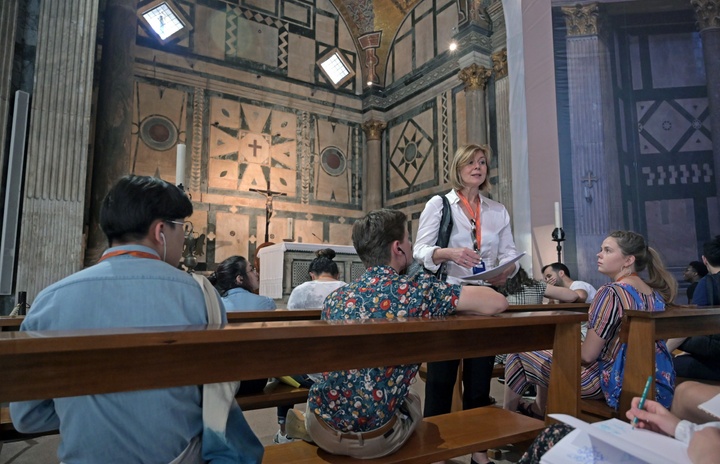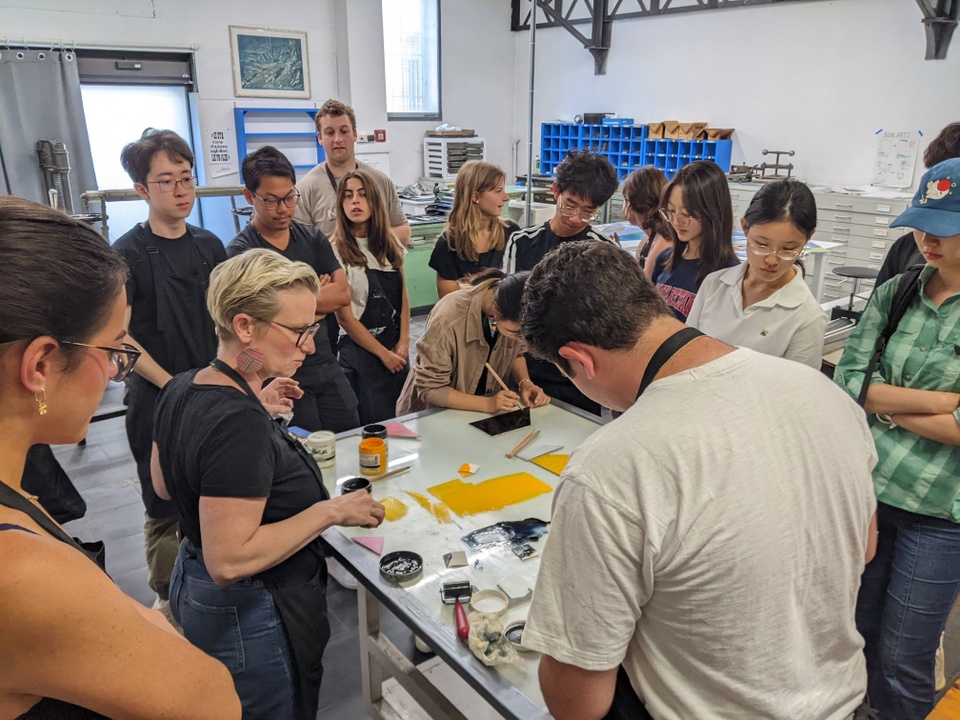Florence Summer Program
Open to all university students, the Florence Summer Program provides an interdisciplinary learning environment to study Architecture, Art, and Art History. You will spend two months broadly examining visual culture as a social, political, and aesthetic construct through an art history course and either an architecture or art studio.
Collaborative in nature, the studios use drawing and design as a medium for exploration and visual experimentation, as you study the nuanced layers of history within the dynamic context of contemporary life. Work in studios extends into the streets of Florence and surrounding cities, allowing you to engage the full cultural landscape of contemporary Europe. The small size of the program allows you to work closely with professors in developing a body of work that is highly personalized, culminating in well-developed final projects.
Courses
Students select one studio.

Architecture Studio 2026
Tavolo Vivente: Architectures of the Culinary Imaginary (6 Credits)
Faculty: Constance Vale
Food is a well-recognized aspect of Italy’s cultural identity. Local histories inform recipes, transferring the past to the present via gustatory tradition. This is not a static cultural narrative but one informed by a vast immigrant population that brings their own culinary traditions, transforming the city’s identity. Food is a part of the everyday; it sustains human life as we cyclically cook, eat, and digest. Food can also take on the status of cuisine, elevating cooking and eating beyond the everyday by virtue of an excess of time and effort and insistence on creativity and novelty. This renders dining an aesthetic experience wherein the gastronomic image is as vital as taste.
Tavolo Vivente, translated as “living table,” alludes to our studio’s vested interest in the gastronomic image. In this studio, we will look to the culinary arts as a starting point to design a restaurant, starting at the intimate scale of a utensil, then increasing in scale to a place setting, a dining table, a room, a building, and garden that relates out to the city. On the one hand, your project will focus on the interior’s object, spaces, color, and atmosphere, while also acting as a microcosm that allows us to explore the role of food in the city at a macro level.
Throughout our travels, you will document your design, observations, and collected artifacts in a coherent fiction. To build up this fiction, you will hybridize past and future by combining media, including printmaking, cyanotypes, photography, photogrammetry, and 3D scanning technology. Gathering, resituating, and analyzing architecture, landscapes, paintings, sculptures, and culinary art from Florence and across Italy, you’ll encapsulate your narrative in a container made to position your discoveries in relation to one another and carry them back with you on your departure.

Art Studio 2026
The Moving Canvas: Adventures in Plein Air (6 Credits)
Faculty: Joe deVera
Students will explore and utilize gouache and watercolor to document their experiences via Plein Air (Open-air/landscape painting) in the historic city of Florence, Italy. The class will undertake the challenges of adaptive painting and create a series of works through direct observation.
Initial studio work will introduce foundational lessons on familiarizing students with gouache and watercolor mediums, along with introducing elements of composition, variations in light/value, abstracting forms, and simplifying/building space. Later, the course will also look toward expanded variations of the medium by utilizing local pigments/earth matter to create added texture, as well as conducting experiments with alternative surfaces and various image transfer methods.
To inform their painting processes, students will heavily utilize site visits, group excursions, and local immersion to provide context and content. Most site visits will be conducted as a class, but students will also be encouraged to conduct their own safe explorations to further personalize their work.
Workshops and guest lectures from visiting artists/scholars may also be included.
Prerequisites: none
All students take Art History and Italian Language.

Art History
Rethinking Renaissance Visual Culture (3 Credits)
Faculty: Katharina Giraldi-Haller
This course explores the complexities, innovations, and magnificence of two centuries of history through its visual production: architecture, painting, sculpture, etc. It challenges the established understanding of Renaissance Florence as a cohesive phenomenon, instead constructing a more diverse notion of Florence’s aesthetic language. Emphasis is placed on those motifs that permit interdisciplinary connections to drawing, design, and architecture that you explore in your studio courses in Florence. Beyond the assigned textbooks, your visual guide is the city of Florence itself.

Italian in Elba
(1 credit)
Offered through a partnership with the Italian language school Europass, this week-long workshop builds a strong understanding of the Italian language and provides an instant immersion in the culture, giving you the necessary foundation for an authentic experience during your time in Florence. Morning classes develop your conversational skills. During the afternoon, you explore the island of Elba through cultural programs, art history classes, and free time. Activities include sailing and swimming in the Tyrrhenian Sea, hiking in the mountains, visiting historic sites such as Napoleon’s fortress in Portoferraio, and enjoying the beach.
Student Work from Florence Summer
Any WashU student can study abroad in the Florence Summer Program. Students must:
- Apply on time
- Have and maintain a 3.0 GPA
- Be in good academic and behavioral standing with the University
- Attend the two mandatory prep meetings before departing for the program
There is no language prerequisite for the summer program.
Students apply at sa.wustl.edu beginning in September 2022.You will write a short essay about your interest in going abroad and what it will bring to your academics and personal experience. You will also submit the name and contact information for two references. More details are given in the application.
Upon successful completion, you receive a total of 10 credits:
- 6 credits of art or architecture studio
- 3 credits of art and architecture history
- 1 credit of Italian Language
For Sam Fox School students, the studio and history courses count toward your major, including as Sam Fox School Elective courses. These credits may also count toward a minor in design, art, or architecture, or fulfill the Humanities credit for engineering students.
Program Dates May 21- July 31, 2026
Living in Florence Florence is a beautiful and vibrant city with outstanding cultural amenities. The school is in the heart of the city near markets, shops, cultural sites, and the train station. Students can share furnished apartments near school. These apartments include air conditioning, Wi-Fi, shared kitchens, laundry facilities, and utilities. Estimated cost per person for shared apartments are $2,400 for a double or triple room and $2,800 for a single room for the length of the program.
Students may also find their own accommodations if they choose to. Costs will vary depending on location, quality, and amenities provided.
Passports & Student Visas Students obtain their own passports, which must be valid for 6 months after the program concludes. The School can assist with your visa application process.
Tuition & Financial Aid A limited number of scholarships are available, based on need and merit. Please indicate on your application if you are seeking financial assistance. Tuition is $16,037. Students are responsible for airfare, food, art supplies, and books. Students will be billed an additional $2,700 approximately for course materials, field trips, museum passes, etc.

























































